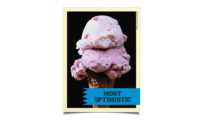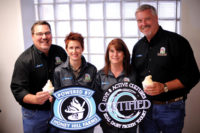
Riding the Wave
by Lynn Petrak
Contributing Editor
Radio frequency identification capability skips to the next generation.
In the game of tag, the
winner is the one the others simply can’t keep up with in the chase.
In the competitive food and beverage suppliers marketplace, there is
another kind of tag that is being played out, with the outcome and
participants yet to be determined.
Radio frequency identification (RFID) technology, in
which devices known as RFID tags are used to store and remotely retrieve
data, has been around for decades in a basic form but has grown more
sophisticated in capability and applications in recent years. In the
production of goods, including perishable foods and beverages like dairies,
RFID has become a part of supply-chain management, encouraged and sometimes
mandated by retailers and used internally by companies looking to gather
and track information about the products they make, store and distribute.
Just exactly how broadly RIFD technology is being
utilized to its potential has become a topic of discussion among those in
supply-chain management, hardware and software systems, RFID systems and in
manufacturing circles. Wal-Mart, the world’s leading retailer, has
required its top 200 suppliers to tag cases or pallets to better gauge
information about products that go through its chain, while the Department
of Defense has an RFID mandate for its suppliers.
“Definitely from compliance initiatives, there
are different areas where you can find RFID in dairy production. From the
Wal-Mart side, there are quite a few dairy companies that are up and
running, and its spans the gamut of milk, cheese and ice cream,”
reports Matt Ream, senior manager for RFID systems at Vernon Hills,
Ill.-based Zebra Technologies, which offers RFID printer/encoders, Smart
Labels, Smart Tags and RFID wristbands, in addition to its line of
printers, software and supplies for bar code labeling applications.
The Wal-Mart effect may be potent in retail circles,
but the pace of RFID implementation by other retailers, including
supermarket chains, isn’t widespread yet. “There are others,
albeit they’ve been a bit sleepy,” Ream says. “You get
glimpses here and there.”
Others agree that RFID has yet to be realized at a
broad level. “There has been kind of a lull now in the applications.
The whole traceability issue is still there, but the industry has slowed
the adoption rate,” says Rick Fox, president and chief executive
officer of Fox IV Technologies, a manufacturer of automated labeling
equipment and supplies including printer-applicators, label applicators,
labels, ribbons and integrated labeling systems.
Meanwhile, John Geary, vice president of Glacier
Computer, LLC, an Amherst, N.H.-based supplier that designs, markets and
supports industrial PC-compatible computer systems for harsh environments
like meat and dairy processing facilities, says that for the ebb and flow
of RFID implementation, there should be an uptick soon. “RFID was
noisy a couple of years when Wal-Mart pushed it to their top 200, then it
slowed,” he says. “But I think the noise has picked up again
over the last six months, due to Wal-Mart and the Department of
Defense.”
If RFID tags are used on more cases and pallets of
finished products as they make their way through the distribution chain,
they can be effective tools for traceability of perishable products as well
as for other product and overall business related reasons. “The power
of it is the tracking without human intervention. If you take a pallet out
of the truck, you want to know where it’s at, and if you take it
through the RFID portal, you know where it is,” Fox says.
Data can be powerful, Ream concurs. “People
focus on the cost of the tags, but the question is what value are you
looking to get out of it, and how much does that save you in reduction of
inventory or waste or spoilage?” he says. “I think Wal-Mart
sees a lot of value, on the fresh produce and dairy side and anything else
with time and temperature sensitive materials, in terms of managing
inventory but also in the management of first-in/first-out
inventory.”
On another plane, beyond track and trace purposes,
there are additional benefits that can be gained from using RFID.
“There is potential for more sophisticated RFID, in sensors that can
tell you if a product has gotten above or below temperature at any point in
time,” Fox says. “That exists in limited adoption right now,
because of the cost, but it is on the horizon, for dairy and meat and other
industries concerned about spoilage.”
According to Tom Sparks, RFID product manager for
Ryder System Inc., Miami, applications that utilize active tags instead of
traditional passive tags provide an enticing return on investment for
perishable producers. “The next step we’re looking at is active
tagging, with real-time location systems. The active tag will send a signal
on a periodic basis that is determined, while a passive tag must have an
incoming radio frequency signal to use energy to send back a signal,”
Sparks explains, adding that there has been a flurry of improvements to
RFID technology in the past few years. “We all started out with the
Generation One tag, those evolved into Generation Two tags that get closer
to 16- to 18-foot range and now with active tagging you can get up to
1,000-foot reads.”
Tags can be used not just for the products within
cases and pallets but in some cases, for containers used to transport dairy
items. “Returnable container tracking is getting interest,”
says Ream, who notes that other industries are embedding plastic containers
with RFID tags to help keep track of them and ensure their return.
Sparks notes that at Ryder’s state-of-the-art,
100,000-square-foot working warehouse laboratory in Fort Worth, Texas, RFID
tags are being used for containers as well as products.
Noteworthy for the dairy industry, on the producer
side, is that RFID tags are being placed directly on live animals for
track-and-trace purposes. “We’re actually tagging cows, using
active tags that are hermetically sealed and are very small. As a cow goes
through a chute or portal, we can know which cow went through which one. We
can get dates, times and medication, and a tag can be re-recorded,”
says Sparks, who points out that a $25 tag is a data-rich investment for a
cow valued at several thousand dollars.
Geary says the industry has just scratched the
proverbial surface of what can be accomplished with RFID and advanced
distribution technology. “Ultimately, it is getting to the point
where some day, store shelves can have RFID readers,” he says.
“You can pull something off the shelf and it will tell the retailer
that an item was sold.”
Sparks, for his part, says that such smart shelves are
already being utilized and experimented with, and that next generation RFID
tags will allow for more closed loop systems in the cold chain, as early as
next year.
For now, possibilities aside, there are a number of
national and regional dairies that are using RFID technology on a regular
basis. Ream cites Dairy Fresh Corp., Greensboro, Ala., part of National
Dairy Holdings, which provides an array of cultured products, as well as a
full line of dairy and assorted other beverages and has used automated RFID
tag application systems on two of its manufacturing lines so customer
mandates could be met in a timely manner. Dairy Fresh invested in a fully
integrated RFID application solution system from Carrollton, Tex..-based
Xterprise Inc., and used components from Zebra Technologies, Ream says.
Other processors have embraced RFID technology as
well. Wells’ Dairy, LeMars, Iowa, complied with the Wal-Mart supplier
demands two years ago, opting to integrate RFID within its production
processes. Among other systems, Wells — maker of frozen dessert and
cultured products — invested in controllers, networking technology
and a visualization platform in recent years.
Tagged for Launch
As applications evolve and emerge in the food and
beverage industries, advanced distribution technologies like RFID are
continually improved as well. Upgrades and new systems are regularly
introduced by technology suppliers, from printers and applicators to print
engines and desktop printers to tag readers and antennas. Other types of
hardware, like rugged computers, and more sophisticated software, are being
rolled out, too.
In May, Zebra Technologies announced the development
of a device service provider interface that allows the company’s RFID
printers to be used with Microsoft Windows based tools.
Last fall, Schober USA, Cincinnati, introduced its
Smart Tag and Ticket Processor (SETP), which incorporates second-generation
RFID technology with the ability to read high-frequency,
ultra-high-frequency and EPC GEN 2 tags, for use in functions ranging from
pallet and case tracking to supply-chain management. Among other
improvements, Schober updated its tag dispensers with new web tensioning
and created strategically placed start and stop buttons, along with
improved information gathering capabilities.
Ryder also continues to upgrade components at its Fort
Worth lab. “We can do provide anything from the tagging of the
product to the middleware solution and the server it resides on to tethered
or secured-line portals and wireless hand-held devices,” Sparks says.
“We have a little bit of everything in our lab.”
Lynn Petrak is a freelance journalist based in the
Chicago area.
$OMN_arttitle="Riding the Wave";?>
$OMN_artauthor="Lynn Petrak";?>

